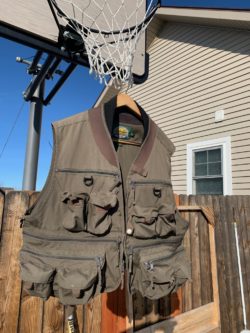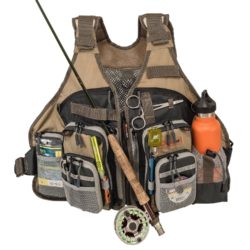Maybe this is not the right word that describes organizing your fishing vest, but it got your attention! A fishing vest is an organized sack. Things that dangle and tangle from your vest are “vesticles” After you have washed and tuned up your vest, here are some organizational ideas to consider. 
Fishermen spend more time looking for stuff than catching. This is because of poor organization. Loading your gear, lures, accessories, hooks, and sinkers becomes a tangled mess in no time. Buckets, creels, sacks, and boxes are all doomed to failure. Anything involving line and hooks becomes an instant tangle.
One day I was fishing a brief hatch on the Gunpowder River in Maryland. They call it the Madison of the East but, that’s because they have rarely been West. Anyway, the Sulphur’s were coming off strong and pods of Big Bows were feasting. I was using a double dry fly rig and the Slay Ride was on. The hatch rarely lasted more than an hour so if you snoozed you lost. The catching stopped when I broke off a fish. Now, I needed to re-rig.
Pretied double rigs in top left pocket. Unwrap neatly from a card in a plastic bag. Tie one knot, snip with hanging sippers, and reach for the Fly Floatant in my front right bottom. A quick application and I was back in action. Thanks to proper organization, I was back on the water in less than 3 minutes. How fast can you re-rig a double dry fly rig 18 inches long with size 16 dressed dry flies?
There is no one right way to organize your fishing vest. Do what works for you. I do suggest that you use your easiest to access pockets for what you use the most. Forceps must be on the exterior pocket for quick use. I do not tie my forceps to a cord. I use the self-locking forceps and secure them to my flap. Any other tools that hang outside your vest became a Tangle waiting to happen.
Hooks and split shot can go in the same pocket. Spinner or lure boxes need to be sized for the Vests pocket sizes. I use the pocket opposite my casting hand to store the fatter lure box. My far-right bottom box has a plastic container filled with emergency stuff. Spare tip tops, bail springs, a lighter, guide cement, wire, tape, etc. I also keep $20 in this container in case I encounter a remote watering hole.
Bait and smelly stuff go in the creel or bucket. Don’t stink up your clean vest with the odor of dead worms, snack wrappers, rotten cheese or corn.
Pick a vest that is bigger than you. Tight is restrictive. You may also need to wear the vest over other clothes.
Use a retractor on your net attached to the large neck clip on your vest. Magnet attachments work fine until you drop the net, the need it to deal with the fish. Folding pocket nets are not stiff enough to support a bigger fish. Your net needs to be high on your back to avoid branches and snags. Use the stiff nylon or rubber nets with wide openings. Closed net fabric wipes off the protective coating from a fish, like a towel.
Pick a vest with bigger pockets and secure closures. Use thinner boxes that fit these pockets. Once you find a vest style that you like, stick with it. I have used the same Cabela’s Three Forks vest since the 1980’s. I am on my 3rd edition. It takes me 20 years to wear them out.
If you take time to organize your vest before you hit the water, you will catch more fish, have less stress, waste less time, and have more fun.
All while looking you best in your vest!
Montana Grant
For more Montana Grant, find him lookin good at www.montanagrantfishing.com.